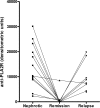Anti-phospholipase A₂ receptor antibodies correlate with clinical status in idiopathic membranous nephropathy
- PMID: 21474589
- PMCID: PMC3109923
- DOI: 10.2215/CJN.07210810
Anti-phospholipase A₂ receptor antibodies correlate with clinical status in idiopathic membranous nephropathy
Abstract
Background and objectives: Circulating autoantibodies against the M-type phospholipase A(2) receptor (anti-PLA(2)R) were recently identified in the majority of patients in the United States with idiopathic membranous nephropathy (iMN). The objectives of this study were to assess the prevalence of anti-PLA(2)R in a separate, European cohort of iMN patients and to correlate the presence of anti-PLA(2)R with clinical parameters reflective of disease activity.
Design, setting, participants, & measurements: Anti-PLA(2)R levels were blindly assessed by a Western blot immunoassay in 54 serum samples from 18 patients with iMN collected in various stages of clinical disease. Anti-PLA(2)R levels were correlated with other clinical parameters.
Results: 77.8% of iMN patients in our cohort had antibodies reactive with human PLA(2)R. The antibody levels in these patients correlated strongly with both clinical status and proteinuria (r = 0.73, P < 0.01).
Conclusions: The role of PLA(2)R as a major antigen in iMN was confirmed in an independent, European patient cohort, and levels of circulating anti-PLA(2)R revealed a strong correlation with clinical disease activity. We propose that detection and measurement of these autoantibodies may provide a tool for monitoring of disease activity and treatment efficacy.
Figures



References
-
- Heymann W, Hackel DB, Harwood S, Wilson SG, Hunter JL: Production of nephrotic syndrome in rats by Freund's adjuvants and rat kidney suspensions. Proc Soc Exp Biol Med 100: 660–664, 1959 - PubMed
-
- Van Damme BJ, Fleuren GJ, Bakker WW, Vernier RL, Hoedemaeker PJ. Experimental glomerulonephritis in the rat induced by antibodies directed against tubular antigens: V. Fixed glomerular antigens in the pathogenesis of heterologous immune complex glomerulonephritis. Lab Invest 38: 502–510, 1978 - PubMed
-
- Debiec H, Ronco P: Fetomaternal alloimmunization with antenatal glomerulopathies. Ann N Y Acad Sci 1110: 559–566, 2007 - PubMed
Publication types
MeSH terms
Substances
Grants and funding
LinkOut - more resources
Full Text Sources
Other Literature Sources

